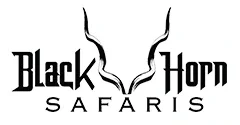Bushbuck hunting is a challenging pursuit that captivates the interest of many experienced hunters worldwide. Bushbuck are the most widespread antelope in Sub-Saharan Africa, and its two main subspecies, Cape and Limpopo Bushbuck, are identifiable by their different colorations.
A successful Bushbuck hunt often involves early morning or late afternoon stalks, when these mainly nocturnal animals are most active. Skilled in the art of camouflage, they offer a truly rewarding hunting experience as it tests the sportsman’s patience, stealth, and marksmanship on a hunt in South Africa.
Description and Characteristics
The Bushbuck is an antelope species found throughout Southern Africa, boasting a range of unique physical and behavioral characteristics. These elegant creatures typically exhibit a rich, russet-brown coat with white markings, which may include spots, stripes, or both, enabling them to blend seamlessly into their natural surroundings. Bushbuck vary in size, with males (also known as rams) often weighing between 90 to 150 pounds, while the slightly smaller females (ewes) generally range between 55 to 110 pounds.
Males are further distinguished by their spiral horns that can grow up to 19 inches long, and the dark, shaggy manes that adorn their throat and neck areas. Predominantly nocturnal, Bushbuck rely on their sharp senses, agility, and mastery of stealth to move through the dense thickets and evade potential predators. This elusive behavior is a defining trait of the species and contributes significantly to the allure. These animals are part of the spiral-horned antelope along with Kudu, Eland and Nyala.
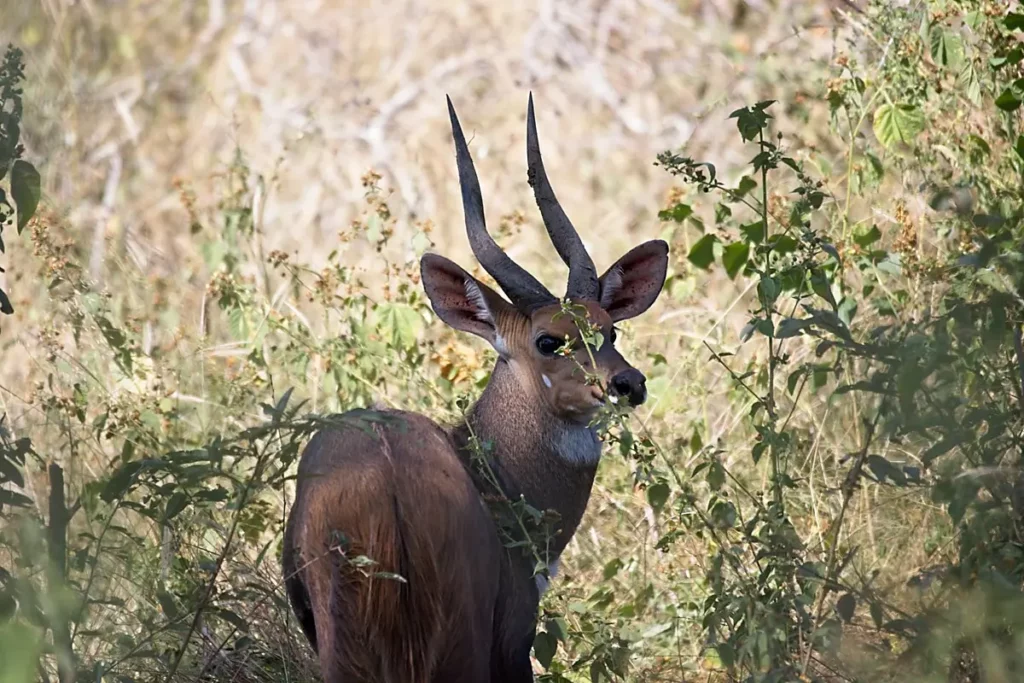

Eastern Cape Bushbuck
The Cape Bushbuck, (Tragelaphus sylvaticus), a specific subspecies of the broader Bushbuck family, is native to the Cape region of South Africa. It has a distinctively darker coat compared to it’s cousin, varying from dark brown to almost black, adorned with white spots on the flanks and white splotches on the ears, chin, tail, and legs. This unique coloration provides excellent camouflage in the shadowy vegetation of its habitat. Males of this species, sport a pair of spiraled horns, but are noticeably heavier, often weighing up to 180 pounds. Cape Bushbuck are solitary animals, with males and females typically only coming together for mating. They are known for their elusiveness and ability to hide, making them a challenging but rewarding quarry. Their preferred habitats include thick bush, riverine forests, and mountainous fynbos. The hunting season for these animals is not limited.
Limpopo Bushbuck
The Limpopo Bushbuck, (Tragelaphus scriptus roualeyni), a subspecies of the larger Bushbuck family, is hunted in the Limpopo River region spanning South Africa, Botswana, Zimbabwe, and Mozambique. This subspecies is typically lighter in color compared to the Cape variety, featuring a reddish-brown to yellowish-brown coat with white spots and patches that assist in camouflage within their bushveld habitats. Males, or rams, possess robust, spiraled horns and can weigh up to 120 pounds, while female bushbuck, known as ewes, are typically smaller and hornless. The Bushbuck is a solitary and nocturnal creature, only coming out at night or early morning, known for its elusive behavior and excellent hiding skills in thick cover.
Other members and species include Chobe Bushbuck, Nile Bushbuck, Abyssinian Bushbuck and Harnessed Bushbuck.
Bushbuck Trophy Size
A significant aspect of hunting African Bushbuck is the potential trophy size, which is usually evaluated based on the size and shape of Bushbuck rams horns. According to the Safari Club International‘s scoring system, a trophy Bushbuck typically has horns measuring around 14 inches or more. However, anything above 15 inches is considered outstanding, and a set of horns over 16 inches is exceptionally rare and highly prized. The horns of a mature ram display a beautiful spiral ridge pattern and a sharp pointed tip, Bushbuck make an aesthetically appealing trophy. Rowland Ward record book minimum for entry is 15 inches and SCI is a score of 31 for rifle and 28 for bow.
World Record
The world record Southern Bushbuck stands proof of the incredible sizes these animals can grow to. Boasting an impressive RW (Rowland Ward) measurement of 21 7/8 inches, and another distinguished specimen exhibiting a SCI measurement of 55 1/8 inches, these huge representatives show what is possible with a bit of luck and the right hunting area.
Best Locations for Bushbuck Hunting in South Africa
Bushbuck hunted in various regions across South Africa, each offering a unique feel and challenges. South Africa, with its diverse terrain, is a popular destination, particularly the Eastern Cape and Kwazulu Natal Provinces known for their abundance of Bushbuck. Obviously Limpopo province is where you need to go to obtain a Limpopo variety Bushbuck.

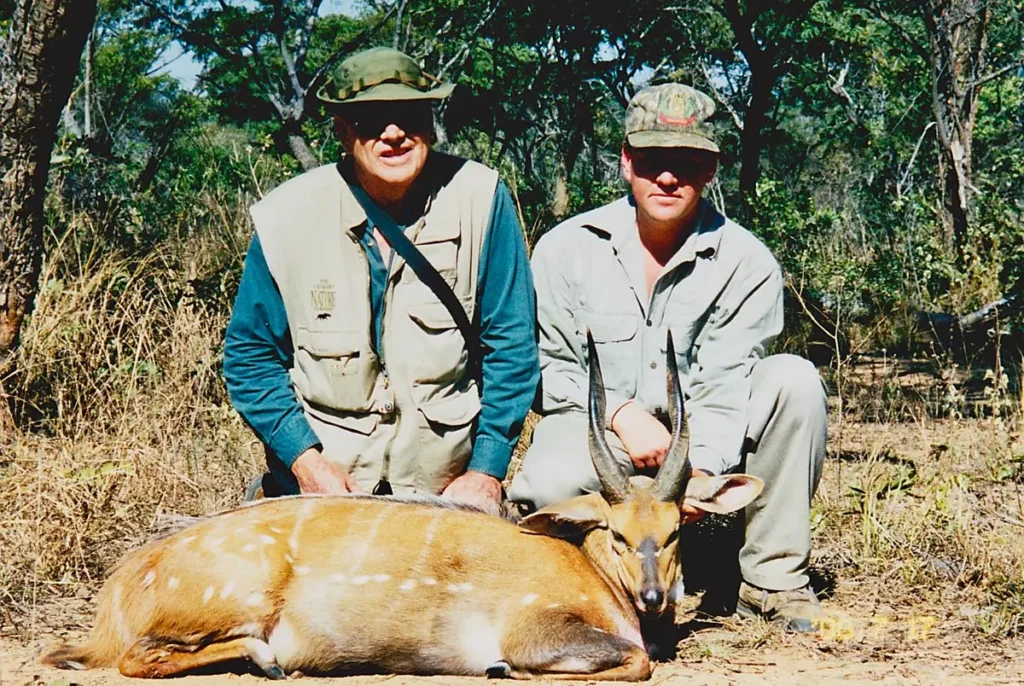
Rifles and Calibers for Bushbuck in South Africa
Choosing the right rifle and caliber for Bushbuck is a crucial part of the process. A rifle that comes to the shoulder and points well is perfect. Given the size and toughness of the Bushbuck, a medium caliber rifle is usually recommended. The .260 Remington, 7 X 57 Mauser, .308 Winchester, and .30-06 Springfield are popular choices for many sportsmen for their accuracy and stopping power.
The bullet selection is equally important and should lean towards a controlled expansion type to ensure a clean, ethical kill. Bullets weighing in the region of 150 – 180 gr. are ideal. This holds true for other plains game.
A rifle with a good balance of weight and maneuverability is ideal, as you will likely be navigating through thick bush and challenging terrain.
Rifle Scopes for Hunting Bushbuck
Choosing the right scope for Bushbuck hunts is important due to the typically challenging environments in which Bushbuck are found. A quality scope should offer a clear and bright image, even in low-light conditions. A variable power scope with a range of around 2-7 X or 3-9 X is a versatile choice, allowing for both close and medium-range shots in dense riverine bush or open bushveld.
In terms of reticles, a simple duplex reticle is usually sufficient for Bushbuck, but illuminated reticles can offer an advantage in low-light situations. With these features in mind, a well-selected scope can significantly enhance accuracy and shot placement.
Best Shot Placement
Achieving an ethical, humane kill is a crucial aspect of hunting, and this requires correct placement of the shot. Bushbuck shot placement is critical, you do not want to wound, wounded Bushbuck can be dangerous and aggressive and will not hesitate to charge. As with most antelope species, the most effective and humane shot is typically a heart-lung shot. This shot aims to disrupt both the heart and lungs, causing rapid loss of consciousness and death due to oxygen deprivation and blood loss. The target area for a heart-lung shot is located just behind the shoulder, approximately one-third of the way up from the bottom of the chest.
For a broadside shots on Bushbuck, aim for the crease where the shoulder meets the body. If the animal is quartering away, the aim point should be adjusted to ensure the bullet will penetrate and pass through the chest cavity and vital organs.
Bow Hunting
Bow hunting Bushbuck demands a blend of skill, patience, and intimate knowledge of the animal’s habits and habitats. Unlike rifle hunting, a bow often requires getting within close proximity of the Bushbuck, typically within 30-40 yards on a hunt, adding an extra layer of challenge due to the Bushbuck’s keen senses and elusive nature.
Guides often employ a spot-and-stalk hunting method, silently moving through good Bushbuck habitat, using the cover of the terrain and vegetation to approach the animal undetected. Hunts from a tree stand or ground blind, especially near feeding or watering areas is often successful. Regardless of the method, successful bow hunting for Bushbuck requires the archer to be patient, choosing the best time of year and make the most of the opportunities that arise.
Shot placement when bow hunting is the same as for rifle hunting.

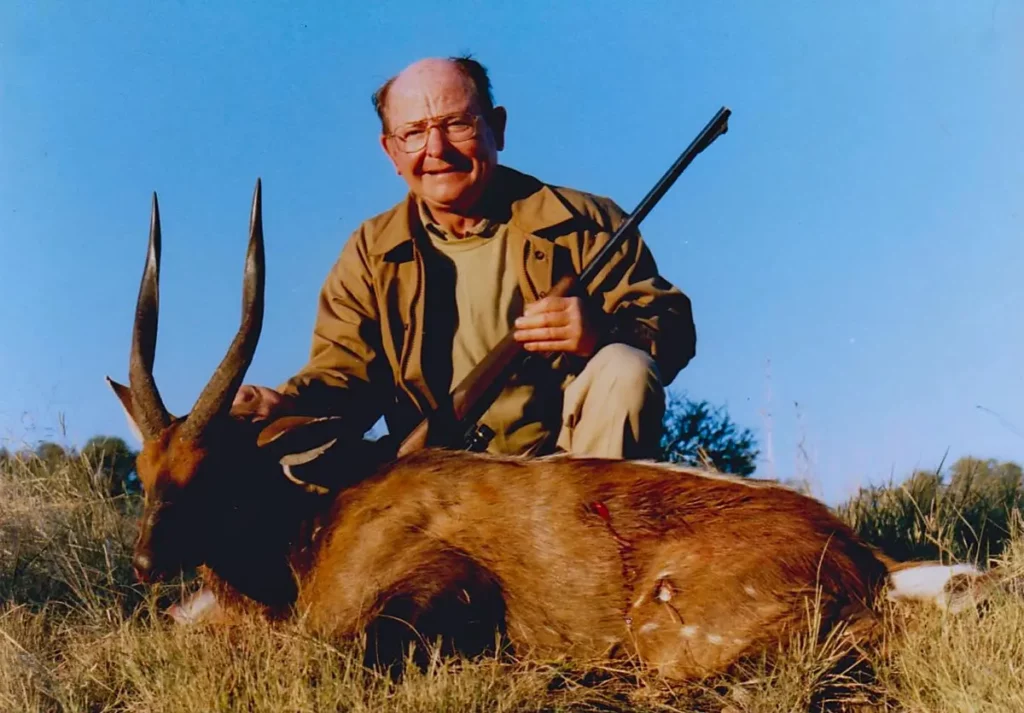
Archery Equipment
When bow hunting the Bushbuck, having the right equipment is an important consideration. A compound bow, with its mechanical advantage and let-off at full draw, is a popular choice for many archers, allowing them to hold their aim longer and with greater stability. The draw weight of the bow should ideally be between 55 to 70 pounds, providing sufficient power to fully penetrate the chest cavity and vital organs for an ethical kill.
Hunting arrows should be well-constructed and matched to the draw weight of the bow, with most archers preferring carbon fiber arrows for their balance of weight, speed, and durability. Broad heads are another essential consideration on a hunt. A mechanical or expandable broad head with a cutting diameter of at least one and a quarter inch is typically recommended to ensure a large wound channel and quick, humane kill.
Prices and costs in South Africa
The price or trophy fee for hunting a bushbuck is $ 1 650.00 and a 7 day hunting package will cost $ 4 100.
Daily rates for Bushbuck hunting trips are:
- 2 on 1 (2 hunters sharing a Professional guide) @ $ 350 per person per day.
- 1 on 1 (the hunter has the services of the Professional guide to himself) @ $ 450 per person per day.
The daily rates include:
- Accommodation
- Meals
- Drinks
- The services of a Professional guide and his tracker
- Field preparation of your animals
- Delivery of trophies to the Taxidermist
- Road transportation to and from Johannesburg International Airport
Hunting Packages in South Africa
Bushbuck are not generally included in hunting packages, but can be added to most packages at a cost of $ 1 650.00.
Take a look at other African plains game packages.
FAQ’S Frequently Asked Questions
Where is the best place for Bushbuck?
South Africa is often a top choice for many sportsmen, with the Eastern Cape, Kwazulu Natal and northern provinces hosting significant populations of Bushbuck, respectively.
Regardless of the location, it’s essential to research working with reputable hunting outfitters to ensure a successful experience.
What does a Bushbuck Hunt cost?
The Bushbuck trophy fee for a hunting trip is $ 1 650.00 and day fees vary from $ 350.00 to $ 450.00 per person per day. So depending on how many days you will be hunting the total cost will be 3 400.00 to $ 4 000.00 for a five day hunting Safari including a Bushbuck.
What is the best rifle caliber for Bushbuck Hunting?
Given the size and toughness of the Bushbuck, a medium caliber rifle is usually recommended. Calibers in the .260 Remington, 7 X 57 Mauser, .308 Winchester, and .30-06 Springfield range are popular choices. The bullet selection is equally important and should lean towards a controlled expansion type or bonded bullet to ensure a clean, ethical kill on your hunt. Bullets weighing in the region of 150 – 180 gr. are ideal for Bushbuck on an African Hunting Safari.
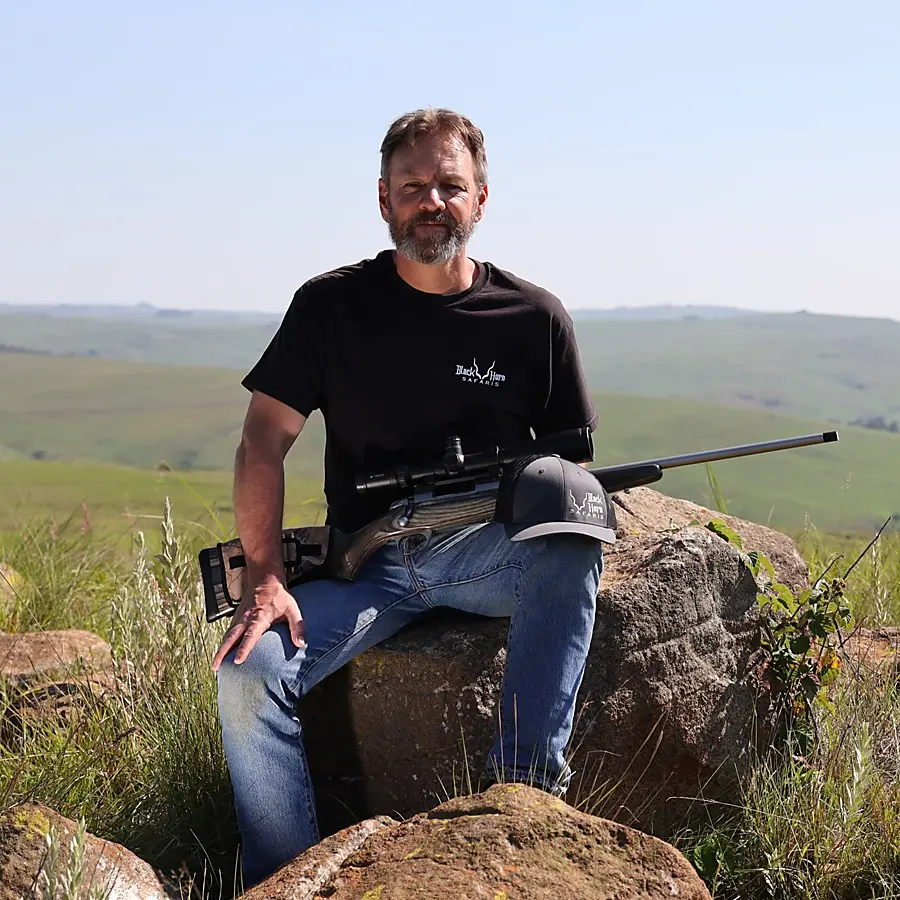
Adrian Anderson first obtained his Professional Hunters license in 1991. He is a Big Five and Dangerous Game licensed Professional Hunter and Hunting Outfitter. He has a tremendous love for wildlife and the African bush and enjoys sharing his knowledge with the hunting clients that he guides. Guiding hunters in Africa’s wild places is a passion and seeing them succeed with their goals brings satisfaction. With knowledge of the Safari industry built up over 32 years he is well qualified to give guidance to his hunting clients.
